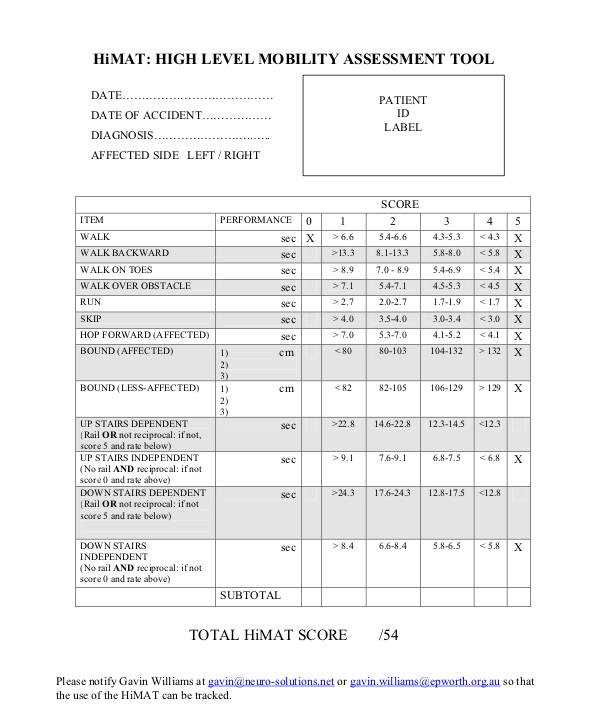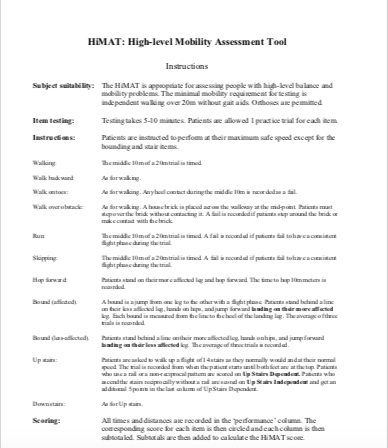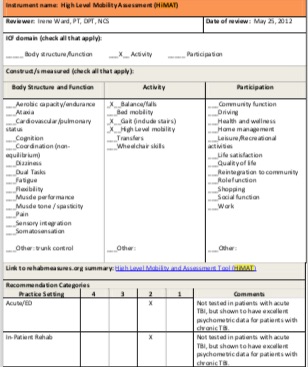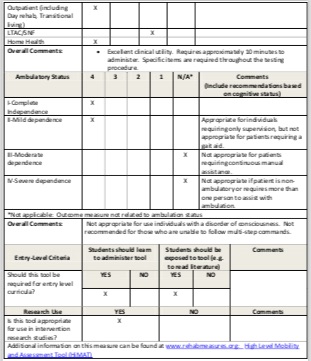Objective
The High Level Mobility and Assessment tool (HiMAT) is a standardized outcome measure used to quantify motor performance in individuals with high-level balance and mobility deficits. It was created by Gavin Williams in 2005 to address a gap in uni-dimensional tools for recording high-level motor function in people with traumatic brain injury (TBI). The HiMAT is scored over 13 items which were derived from the opinions’ of expert clinicians and from existing multi-dimensional mobility scales.
[1]
Intended Population
Although designed for use with patients with TBI, the HiMAT can be used for a number of other neurological and musculoskeletal conditions that result in vestibular and motor deficits. For example, in stroke victims and Parkinson’s disease patients – particularly in young adults[2]. As per the tool instructions, those being assessed using the HiMAT must at least have the ability to walk greater than 20 meters independently without gait aids and with or without orthoses.
Method of Use
Equipment Required
- at least 20m even surface walkway
- 1 house brick
- access to a flight of 14 stairs
- stopwatch
- tape measure
- pen and a copy of the HiMAT tool
Preparation of Environment
- Measure and mark a 20m walkway to count the middle 10m
Instructions
- Patients are permitted 1 practice trial per item
- Patients are to perform each task at the maximum safe speed except for bounding and stair items
- All items (except stairs) are timed or counted in the middle 10m of the 20m walkway
- The items to be scored are: {| class=”wikitable” !HiMAT TASKS |- |walk |- |walk backwards |- |walk on toes |- |walk over obstacle |- |run |- |skip |- |hop forward (affected) |- |bound (affected) |- |bound (less affected) |- |up stairs dependent (rail OR not reciprocal; if not score 5 and rate below) |- |up stairs independent (no rail AND reciprocal: if not score 0 and rate above) |- |down stairs dependent (rail OR not reciprocal; if not score 5 and rate below) |- |down stairs independent (no rail AND reciprocal: if not score 0 and rate above) |}
Scoring
- Each item is catergorized into points 1 being the lowest score and 4 being the highest
- The faster the task is completed OR the greater the distance achieved, the higher the score
- Total score is out of 54
Evaluation
In January 2013, the Traumatic Brain Injury Evidence Database to Guide Effectiveness (TBIEDGE) task force presented a compilation of outcome measure recommendations for clinicians working with TBI patients. Below is a table showing their final recommendations; the conclusion being that the HiMAT is highly recommended in the outpatient setting as a standardised outcome measure.[4]
References
- ↑ Williams G, Robertson V, Greenwood K, Goldie P & Morris, M. The high-level mobility assessment tool (HiMAT) for traumatic brain injury. Part 1: Item Generation, Brain Injury, 2005;19(11): 925-932.↑ Williams G, Robertson V, Greenwood K, Goldie P & Morris M. The high-level mobility assessment tool (HiMAT) for traumatic brain injury. Part 2: Content validity and discriminability, Brain Injury, 2009;19(10):833-843↑ Carl Peterson. Neuro #3, Outcome Measure: High Level Mobility Assessment Tool. Available from ↑ McCulloch K, De Joya A, Donnelly E, Kayes K, Johnson T, Nirider C, Roth H, Saliga S, Ward I. TBIEDGE Task Force Recommendations for the Academy of Neurologic Physical Therapy Outcome Measures Recommendations. Available at Resources




